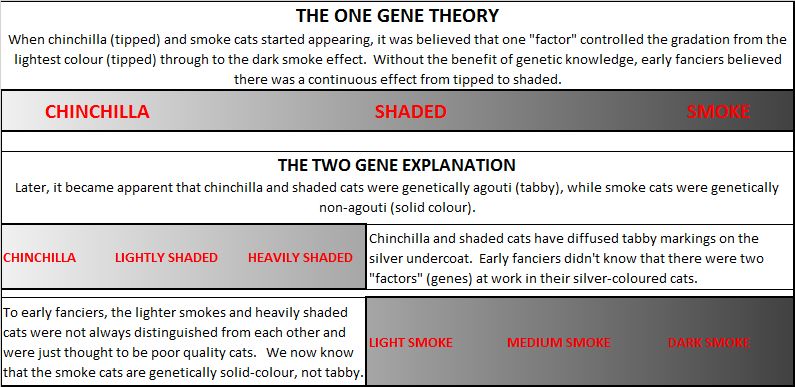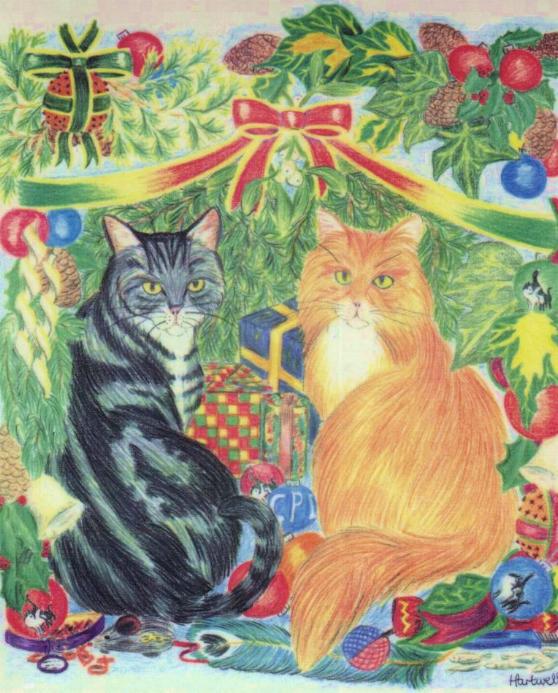
PAST AND PRESENT GENETIC THEORIES FOR SILVER AND GOLDEN SERIES
DISPROVEN: A Version of Albino
The earliest genetic theory suggested the Chinchilla gene was a version of albino. Work by Keeler and Cobb suggested that the gene producing "silver" or "smoke" in cats was an allele of the gene that produced the Siamese coat pattern (which is a form of albinism). They wrote that "silver" produced the following types of hair (1) all white, (2) all black (in dark silvers or smokes), (3) black hairs with white tips, (4) hairs with white and grey or black bands, and (5) white hairs with black tips. This theory ruled out the possibility of Shaded Sepia, Shaded Mink and Shaded Pointed colours, which have all occurred in experimental breeding (even if not present on the showbench). Keeler and Cobb’s theory proved incorrect.
DISPROVEN: A Single Dominant "Factor"
Another early theory proposed a single dominant "factor" (Inhibitor gene), but this could not explain the variations of shading. Many early breeders, without the benefit of genetics knowledge, understood there were "factors" controlling colour and pattern, but did not realise that two factors – agouti and non-agouti - were involved. They thought the cats fitted on a single continuum from smoke through to chinchilla, and they thought that darker shaded silvers (agouti) were poor quality smokes (non-agouti). Likewise, some Shaded Silvers were considered to be poorly marked Smokes. Eventually, breeding would demonstrate that Smoke cats were genetically different from Shaded and Chinchilla (Tipped) cats and not variable expression of a single gene.

A variation of this suggested two forms of Inhibitor: Sh (shaded silver) being the mild form, while Ch (chinchilla) was the strong form. The flaw in this theory is that there are heavily marked Chinchillas and lightly marked shaded silvers that sit midway between the two patterns i.e. silvering is a continuum. This pointed to polygenes that affect the degree of silvering/bleaching in the agouti fur.
DISPROVEN: A Silver Bleaching Gene + Eraser Gene
Another theory suggests two interacting genes called silver bleaching (Sv) that cancels rufousing, and eraser (I) that causes silver at the base of the hair. The Sv gene would cancel rufousing in eumelanin colours, but have less effect on phaeomelanin colours, hence red smokes and red shaded silvers have much warmer tones. However, following this theory (which we won’t do here) a non-agouti cat with Inhibitor + svsv should be a golden smoke. In reality, golden smokes do not occur. Also, shaded cats with a dark band at the base of the fur are predicted by the theory, but do not occur in reality. These mean the I + Sv theory cannot be correct.
UNPROVEN: Golden Epistatic Gene
According to this theory, goldens are caused by an epistatic gene, "g", that affects the expression of gene I. This is a bit like the way dilution influences the expression of black, chocolate and cinnamon. The other allele, G, has no action i.e. it does not produce golden pigmentation at the base of the hair.
UNPROVEN: Golden Phenotype = Brown Ticked Tabby
Perhaps shaded goldens are ticked tabbies, Because pigmentation is heat-dependent, the coat color is usually lighter near the skin. The golden and the ticked tabby phenotypes are often very similar. However, this does not explain is why some ticked tabbies are only a little depigmented near the skin while the goldens are more depigmented near the skin. Polygenes, perhaps, in which case we can include the Wide Band effect. Goldens are bred from shaded silver and chinchilla lines, where those cats are selected for the greatest possible amount of depigmentation. Two chinchilla or shaded silvers heterozygotic for the inhibitor gene should produce ticked tabby kittens that look like goldens.
CURRENT ACCEPTED THEORY: Wide Band
In addition to the dominant Inhibitor gene (not present in the Golden series), a good quality silver cat will also have the Wide Band effect. Although we talk of Wide Band as a gene, it is really polygenes (multiple interacting genes), but for convenience we treat it as a single gene. This determines the width of the pale band between the pigmented tip and the follicle. The undercoat length varies, being narrow on the cat's back and wider at the belly. The presence or absence of the Inhibitor gene does not affect Wide Band since Golden Shadeds lack the Inhibitor gene, but have a shading pattern comparable to Silver Shaded cats.
Non-agouti + Wide Band = Solid Colour
Non-agouti + Wide Band + dominant Silver = Smoke Pattern
Agouti + Wide Band = Golden series
Agouti + Wide Band + dominant Silver = Silver series
There may be additional genes for banding frequency, band width and band placement which influence the banding pattern of the hairs. An ideal Shaded Silver hair has a single broad band of pigment at the tip of each hair. In life, Shaded Silvers have a mix of three patterns: a single broad band and wide undercoat; a few broad bands and wide undercoat or multiple thin bands (as seen in the background colour of Silver Tabbies). The criteria for each degree of tipping is an ideal and there are many cats that visually fall between two ideals.
Burmilla breeders rarely saw tipped cats in early generations, but saw them frequently in later generations. They suggested that a second recessive "super wide band" gene for tipping, but polygenes with an additive effect are more likely.
In goldens, wide band refers to the yellow banding of the hair shaft. A eumelanin series cat (black/brown) can be homozygous for Wide Band and have no Inhibitor gene (or have the recessiver form or inhibitor) making it Golden, so the undercoat is warm cream or apricot. For that reason, it's suggested that some poor quality silvers were really pale creamy goldens.
Posited Modifier Genes
Other genes influence the number and width of coloured bands on each hair and reduce or eliminate residual tabby markings on the chest, legs and sometimes tail.
Some tipped and shaded silver shorthairs may have the ticked (Abyssinian-type) tabby gene in addition to the classic or mackerel tabby gene(s). This only shows up if matings of Shaded Silvers to Classic Tabbies unexpectedly produce ticked tabby kittens. Since ticked tabby masks out any other tabby pattern, it could only have been carried by the Shaded Silver parent. Tipped or Shaded Silver kittens born without a tabby pattern probably carry the ticked tabby gene, while those born with a discernible tabby pattern may lack the ticked tabby gene.
Breeder of Shaded Silver American Shorthairs, Carol W Johnson, suggested at least two modifier genes that affect ticked tabbies and dissipate residual tabby markings in shaded shorthairs. She referred to them as Chaos and Confusion. A third gene. "Erase" was proposed by Cathy Galfo (working with Oriental Shorthairs) and appears to reduce or remove residual barring on the extremities. These names describe effects rather than actual genes. Johnson noted that the each hair in a shaded cat differs in band number and width; ranging from solid colour and solid white through to multiply banded and singly banded. She termed this "Confusion" as it "uncoordinated" the hair follicles to so that they produced different banding patterns to their neighbours. In contrast, Abyssinian-type ticked tabbies have even banding and relatively even colouration which stops abruptly at the belly (like a tide mark on a boat!). Shaded cats with high levels of Confusion (uneven band width) had a more mottled or "sparkling" appearance and a more gradual blending and fading of the colour from back to belly.
However, the confusion effect can be achieved with polygenes. Except for genes on X and Y chromosomes, each cell has 2 copies of each gene. The 2 copies might be identical or different and normally one is dominant to the other. Sometimes, e.g. when the genes are different but co-dominant, one copy is deactivated; this happens in foetal development. One cell might have activated the gene telling it to make 3 bands of colour while the cell next to it might have activated the slightly different copy of the same gene telling it to make 5 bands of colour. There might be a gene located elsewhere on the chromosome which, if switched on, override those genes entirely with an instruction to make a solid coloured hair! So while "Confusion" is a good name for the phenomenon on a visual level, a single Confusion gene seems unlikely.
Johnson's "Chaos" gene further disrupts the striped pattern by abnormally mixing ticked hairs into normally solid coloured regions (and vice versa). This effect is visible in the modified tabby pattern of the Sokoke. A mechanism for this was described by Australian Mist breeder Truda Straede who suggested a gene that disrupted a normal tabby pattern into a "finely divided tabby pattern" (Striped and Spotted Cats). Straede had never seen the Sokoke, but predicted the pattern’s existence based on her work with "small pattern spotted tabbies" and "large pattern spotted tabbies". Chaos might eradicate residual necklaces and ghost striping in ticked tabbies and in Shaded cats. In addition to Confusion and Chaos, Johnson hypothesised a rarer gene causing roan where solid white hairs are intermixed with normal hairs. In Shaded shorthairs, "roan" might result in Shaded Silvers so pale as be visually Chinchillas. (As an aside, roan hasn’t been identified in silvers, but it is found in the Lykoi breed and in the karpati pattern found in Eastern European cats).
|
Agouti |
Inhibitor |
Wide-band effect |
Tabby (ticked) |
Phenotype |
|
A- |
I- |
Wb- |
Ta- |
silver tipped (shell) or shaded |
|
A- |
I- |
Wb- |
tata |
“wide band” silver tabbies (mackerel, classic) |
|
A- |
I- |
wbwb |
Ta- |
silver ticked tabby |
|
A- |
I- |
wbwb |
tata- |
silver tabby (mackerel, classic) |
|
A- |
ii |
Wb- |
Ta- |
golden tipped or shaded |
|
A- |
ii |
Wb- |
tata |
golden tabbies (mackerel, classic) |
|
A- |
ii |
wbwb |
Ta- |
ticked tabbies (non-silvered) |
|
A- |
ii |
wbwb |
tata- |
other tabbies (non-silvered) (mackerel, classic) |
|
aa |
I- |
Wide band (poly)genes and tabby genes cannot express if [aa] |
silver smoke | |
|
aa |
ii |
Wide band (poly)genes and tabby genes cannot express if [aa] |
solid/self colour | |
